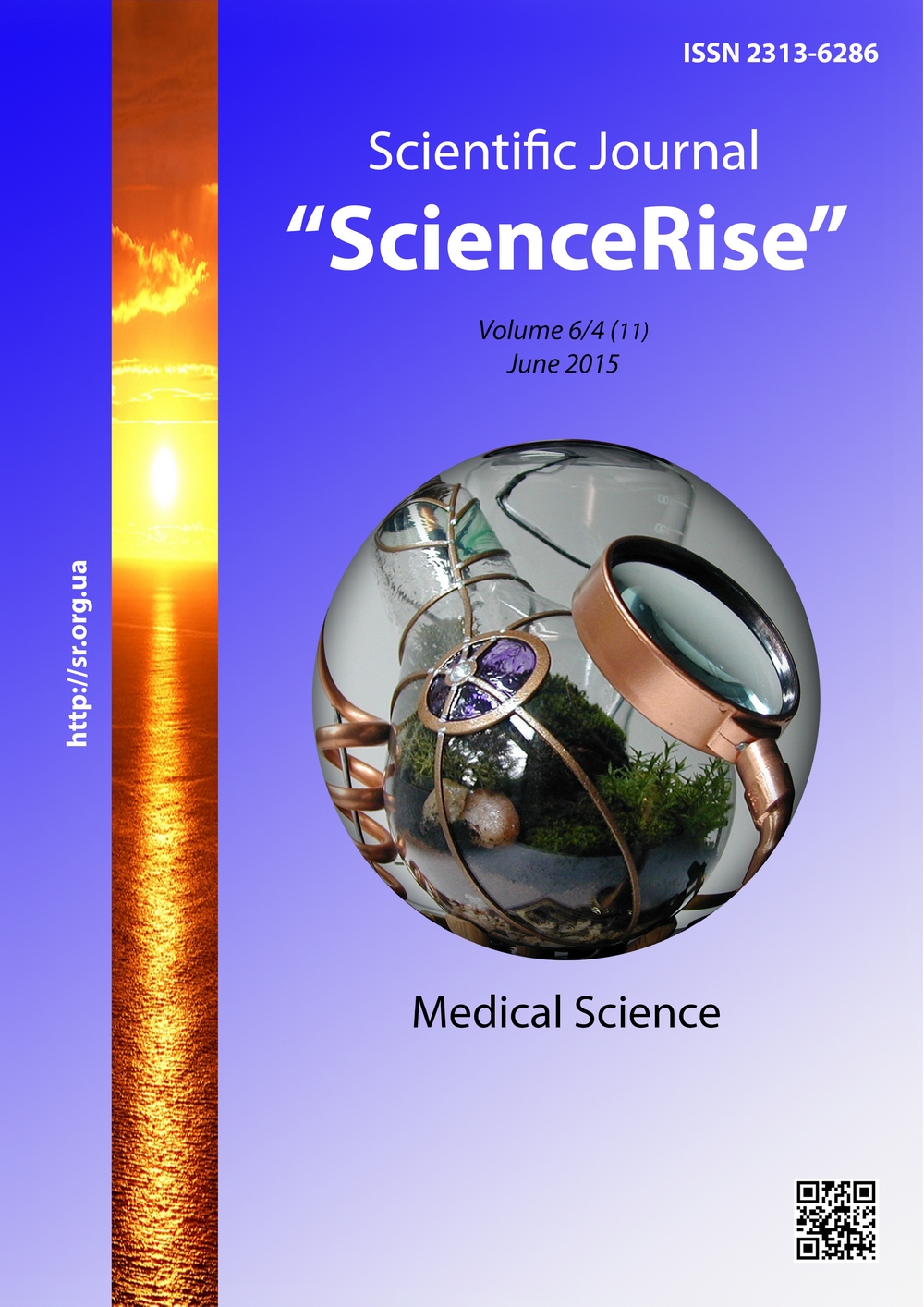Methodological aspects of magnetic resonance tomographic diagnostics of metastatic compressive fractures of the spine
DOI:
https://doi.org/10.15587/2313-8416.2015.45164Keywords:
МРТ, metastatic compressive fracture, pulse patterns, signal characteristicsAbstract
Aim of the study – to define an information value of the different pulse patterns for a qualitative estimation of MR-signals in the body of compressed vertebras.
Methods: 50 patients with metastatic compressive fractures (MCF) were examined using MRT. 30 (60%) mans and 20 (40%) woman, average age 60,8 +/- 12,5 years. Fractures in the different parts of spine were considered: cervical – 6 (12,0); thoracic – 25 (50,0 %); lumbar – 19 (38 %). Metastasis in the spine are more frequent at a cancer of mammary gland (20,0 %), kidneys (17,5 %) and prostate gland (15,0 %), less frequent at a cancer of lungs, thyroid gland and sarcomas (7,5 %).
MRT was done for all patients using apparatus with magnetic force 0,2, 1,5 and 0,36Т (AIRIS Mate, ECHELON of "HitachimedicalCorp.", Japan, “I-Open 0, 36” Chine)in 3 projections receiving Т1-, Т2- weighted (Т1WI, Т2WI) and diffusion-weighted images (DWI)and also images with suppression of signals from an adipose tissue (STIR, Fat/sat).
Results: the more obvious pulse patterns (PP) at MCF of spine are – STIR (97,8 %), Т1WI и DWI (80 %). DWI can be used as a screening and addition for above-listed PP. The more objective criterion for a judgment about MCF is abnormal uptake of CM (60 %) on diffuse type.
Conclusions: for MRT visualization of MCF the most optimal are the next PP – STIR, Т1WI and DWI, with a sensitivity, respectively – 97,8 %, 80 %, and 80 %. DWI must supplement but not substitute all existing PP. On the post-contrast T1WI an objective criterion for MRT diagnostics of MCF is an abnormal uptake of CM on diffuse type. An alteration of signal characteristics in the body of compressed vertebras is an evidence of an alteration of structure, but for more precise definition of its character it is necessary to study its morphological alterations
References
Sedakov, I. E. (2013). Ukrainskayaonkologiya v 2012 godu: reformy, dostizheniya, innovacii. Zdorov'e Ukrainy, 3, 6–7.
Kassar-Pullichino, V. N., Imhof, H. (2009). Spinal'nayatravma v svetediagnosticheskihizobrazhenij [Spinal injury in the light of diagnostic imaging]. Moscow: MEDpress-inform, 264.
Shah, L. M., Salzman, K. L. (2011). Imaging of Spinal Metastatic Disease. International Journal of Surgical Oncology, 2011, 1–12. doi: 10.1155/2011/769753
Nered, A. S., Kochergina, N. V., Bludov, A. B. (2013) Osobennostipatologicheskihperelomovpozvonkov. REJR, 3/2, 20–25.
Geith, T., Schmidt, G., Biffar, A., Dietrich, O., Dürr, H. R., Reiser, M., Baur-Melnyk, A. (2012). Comparison of Qualitative and Quantitative Evaluation of Diffusion-Weighted MRI and Chemical-Shift Imaging in the Differentiation of Benign and Malignant Vertebral Body Fractures. American Journal of Roentgenology, 199 (5), 1083–1092. doi: 10.2214/ajr.11.8010
Hamimi, A., Kassab, F., Kazkaz, G. (2015). Osteoporotic or malignant vertebral fracture? This is the question. What can we do about it? The Egyptian Journal of Radiology and Nuclear Medicine, 46 (1), 97–103. doi: 10.1016/j.ejrnm.2014.11.010
Shah, L. M., Hanrahan, C. J. (2011). MRI of Spinal Bone Marrow: Part 1, Techniques and Normal Age-Related Appearances. American Journal of Roentgenology, 197 (6), 1298–1308. doi: 10.2214/ajr.11.7005
Tanenbaum, L. N. (2013). Clinical Applications of Diffusion Imaging in the Spine Diffusion imaging in the spine. Proc. Intl. Soc. Mag. Reson. Med, 21, 1–21.
Pongpomsup, S., Wajanawichakorn, P., Danchaivijitr, N. (2009). Benign versus valignant compression fracture:a diagnostic accuracy of magnetic resonance imaging. J Med Assoc Thai92, 1, 64–72.
Baur, A., Stäbler, A., Arbogast, S., Duerr, H. R., Bartl, R., Reiser, M. (2002). Acute Osteoporotic and Neoplastic Vertebral Compression Fractures: Fluid Sign at MR Imaging1. Radiology, 225 (3), 730–735. doi: 10.1148/radiol.2253011413
Karchevsky, M., Babb, J. S., Schweitzer, M. E. (2008). Can diffusion-weighted imaging be used to differentiate benign from pathologic fractures? A meta-analysis. Skeletal Radiol, 37(9), 791–795. doi: 10.1007/s00256-008-0503-y
Herneth, A. M., Guccione, S., Bednarski, M. (2003). Apparent Diffusion Coefficient: a quantitative parameter for in vivo tumor characterization. European Journal of Radiology, 45 (3), 208–213. doi: 10.1016/s0720-048x(02)00310-8
Resnick, D. (Ed.) (2006). Skeletal Metastases. Bone and Joint Imaging. Philadelphia, Pa: WB Saunders Co, 1076–1092.
Downloads
Published
Issue
Section
License
Copyright (c) 2015 Александр Павлович Мягков, Станислав Александрович Мягков, Александр Сергеевич Семенцов, Сергей Юрьевич Наконечный

This work is licensed under a Creative Commons Attribution 4.0 International License.
Our journal abides by the Creative Commons CC BY copyright rights and permissions for open access journals.
Authors, who are published in this journal, agree to the following conditions:
1. The authors reserve the right to authorship of the work and pass the first publication right of this work to the journal under the terms of a Creative Commons CC BY, which allows others to freely distribute the published research with the obligatory reference to the authors of the original work and the first publication of the work in this journal.
2. The authors have the right to conclude separate supplement agreements that relate to non-exclusive work distribution in the form in which it has been published by the journal (for example, to upload the work to the online storage of the journal or publish it as part of a monograph), provided that the reference to the first publication of the work in this journal is included.

